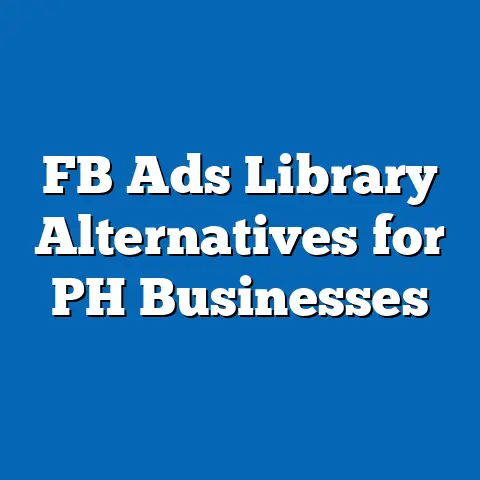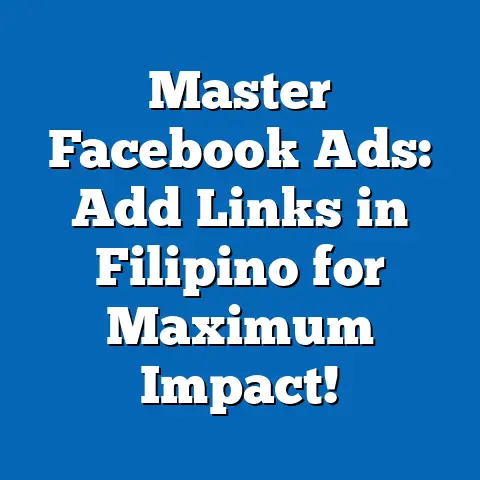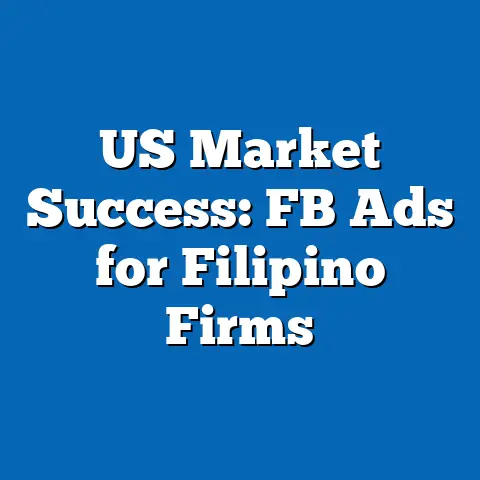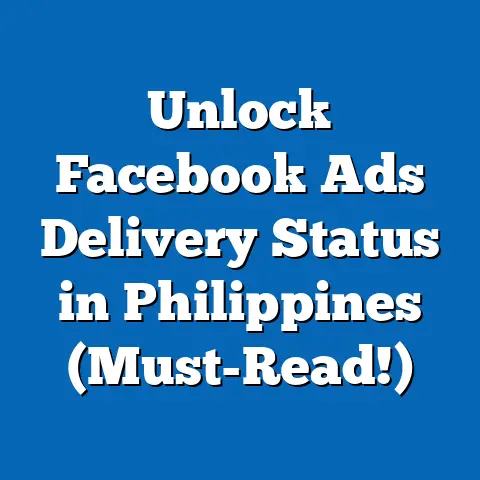Master FB Ads Library API for PH
Imagine running your small business in Manila or Cebu, pouring blood, sweat, and tears into your Facebook ads, only to feel like you’re shooting arrows in the dark. You see some clicks, some sales, but you have no real idea what your competitors are doing, which ads resonate best with your target market, or how to optimize your campaigns beyond guesswork. On the other hand, imagine having a crystal-clear window into the entire Facebook advertising ecosystem in the Philippines—being able to analyze top-performing ads, discover winning creatives, and understand your market’s behavior deeply.
That’s exactly what mastering the Facebook Ads Library API can do for you.
I remember when I first discovered the power of the FB Ads Library API. It was like switching on a light in a dark room. Suddenly, I could see not only my own ads but also what my competitors were running, which messages hit the mark, and which didn’t. This treasure trove of data transformed how I approached Facebook advertising for Filipino businesses.
In this article, I will take you through everything you need to know about the FB Ads Library API — what it is, why it matters specifically for the Philippine market, how to use it effectively, and how you can leverage it to make smarter ad decisions that drive sales and growth.
What is the Facebook Ads Library API?
Before diving deep, let’s clarify what this tool really is.
The Facebook Ads Library is a public database where Facebook displays all active ads running across its platforms. It’s a transparency initiative meant to help users see who is advertising and what messages are being promoted.
The Ads Library API takes this a step further by allowing developers and marketers like us to programmatically access this data. Instead of manually browsing through ads, we can pull large volumes of data on ads filtered by location, advertiser, keywords, and more.
Why Should Filipino SMBs Care?
The Philippine market is vibrant but competitive. Filipino consumers are savvy social media users — Facebook remains the top platform with over 80 million active users as of 2024. This means your competitors are also likely heavily invested in FB ads.
Using the Ads Library API helps level the playing field:
- Spy legally on competitor strategies
- Find trending ad creatives and messaging that resonate locally
- Discover gaps in ad targeting and content
- Optimize your own ads based on real-time market insights
In essence, it’s a powerful tool that Filipino small and medium-sized businesses (SMBs) can use to understand their digital environment better—helping them make data-informed decisions instead of relying solely on intuition or expensive guesswork.
How Does the FB Ads Library API Work?
The API lets you fetch detailed information about active ads including:
- Advertiser name and ID
- Ad creation date and status
- Ad creative details (images, videos, text)
- Targeting parameters (location, demographics)
- Impressions and engagement metrics (limited)
Access Requirements
To use the API, you need:
- A Facebook developer account
- An app with approved permissions for
ads_managementorads_read - Compliance with Facebook’s data use policies
Once set up, you can query the API endpoints to get data filtered by country (set to Philippines), advertiser ID, or specific keywords relevant to your niche.
The Philippine Market Context: Why Localization Matters
Facebook usage in the Philippines is unique in many ways compared to global trends. Here are a few key points:
1. Facebook Penetration and Usage Patterns
According to recent data:
- Over 70% of Filipinos aged 13+ use Facebook daily.
- Mobile devices dominate access—over 95% of users access via smartphones.
- Peak usage times align with local lifestyle—early mornings before work/school and evenings after dinner.
2. Language Diversity
While Tagalog/Filipino is widely understood and used in Metro Manila and Luzon, Visayan dialects like Cebuano dominate in Visayas and Mindanao regions. English is also commonly mixed into conversations online.
This means successful ads often use a mix of languages or dialects tailored to target audiences’ locations.
3. Cultural Nuances
Filipinos respond well to humor, emotional storytelling (“hugot”), and values like family unity and bayanihan spirit (community cooperation). Ads that incorporate these elements tend to perform better.
4. Economic Factors
SMBs often work with limited budgets but operate in highly competitive sectors such as retail (clothing, food), services (travel agencies), and e-commerce.
Understanding these local nuances through data from the Ads Library API allows businesses to craft messages that truly resonate instead of generic global templates.
Deep Dive: What Filipino SMBs Can Extract from the API
1. Competitor Analysis Made Easy
Instead of guessing what your competitors are doing, pull their active ads directly from the API:
- See what offers they promote
- Analyze ad formats (video vs carousel vs image)
- Identify their messaging tone — formal? conversational? humor?
- Note their call-to-action buttons and landing pages
For example, a local coffee shop chain might discover that competitors are running limited-time discount video ads targeting Manila millennials with “Buy 1 Get 1” promos. This insight allows them to craft unique offers or improve their creatives.
2. Tailoring Localized Ads by Region
Using location filters within the API lets you observe which ads perform well in different parts of the Philippines:
- Ads using Cebuano language perform better in Cebu City.
- Offers focusing on fiesta celebrations get more engagements in Iloilo.
- Metro Manila audiences prefer modern minimalist designs with English copy.
This helps you avoid a one-size-fits-all approach that wastes budget targeting uninterested groups.
3. Identifying Emerging Trends
By aggregating ad data over time, you can spot rising trends in product categories or marketing styles:
- Surge in wellness brands promoting herbal supplements via video testimonials.
- Increased use of influencer marketing by fashion brands targeting Gen Z.
- Growth in e-commerce ads highlighting free shipping promos during holiday seasons.
Knowing these trends early gives you a competitive edge.
4. Creative Inspiration and Best Practices
The API provides access to actual creatives used by other advertisers:
- Discover what colors, fonts, visuals resonate with Filipino audiences.
- Learn effective storytelling structures (e.g., problem-solution narrative).
- Identify common mistakes to avoid (too much text on images, unclear CTAs).
Step-by-Step Guide: How to Use FB Ads Library API for Your Business
Step 1: Set Up Your Developer Account and App
Go to Facebook for Developers:
- Create an account or log in.
- Click “Create App.”
- Choose app type (“Business” usually fits ad-related tools).
- Name your app clearly (e.g., “PH SMB Ad Analysis”).
- Complete setup steps.
Step 2: Request Permissions
Apply for ads_read permission:
- Provide details about your use case.
- Explain how you’ll respect user privacy and data rules.
- Wait for approval (can take days).
Step 3: Generate Access Tokens
Once approved:
- Use Facebook’s Graph API Explorer or your application dashboard.
- Generate user access tokens or page tokens with required scopes.
Step 4: Define Your Query Parameters
To fetch ads relevant to PH SMBs:
- Set
ad_reached_countries=['PH']. - Use search terms relevant to your niche: “bakery,” “travel agency,” “online store.”
- Optional: filter by advertiser IDs if targeting known competitors.
Example Graph API request:
GET /ads_archive?search_terms=bakery&ad_reached_countries=['PH']&fields=ad_creative_body,ad_creative_link_caption,ad_creative_link_description&access_token=YOUR_ACCESS_TOKEN
Step 5: Analyze Data
Extracted data can include:
- Text content for messaging analysis
- Media URLs for creative designs
- Engagement stats like reactions or comments when available
Use Excel or visualization tools like Tableau or Google Data Studio for deeper insights.
Advanced Tips for Filipino SMBs Using FB Ads Library API
Automate Data Collection with Scripts
If you’re comfortable with Python or JavaScript:
- Write scripts using Facebook’s SDKs.
- Schedule regular data pulls to keep insights fresh.
- Combine with Google Sheets API to track trends over time.
Example Python snippet using Facebook Graph API (simplified):
import requests
ACCESS_TOKEN = 'YOUR_ACCESS_TOKEN'
url = 'https://graph.facebook.com/v17.0/ads_archive'
params = {
'search_terms': 'bakery',
'ad_reached_countries': ['PH'],
'fields': 'ad_creative_body,ad_creative_link_caption',
'access_token': ACCESS_TOKEN
}
response = requests.get(url, params=params)
data = response.json()
print(data)
Combine With Other Tools for Holistic View
Use Ads Library data alongside:
- Facebook Audience Insights for demographic profiles
- Google Analytics for website traffic correlation
- Social listening tools (e.g., Brandwatch) for sentiment analysis
This gives a full picture beyond just ad creatives.
Case Studies: Filipino Businesses Winning With FB Ads Library Insights
Case Study #1: Cebu-Based Online Boutique
A friend runs a small clothing boutique in Cebu City. They struggled with Facebook ad performance despite decent traffic. After integrating data from the FB Ads Library API:
- They identified top-performing competitor ads focusing on casual wear with playful taglines.
- Noticed heavy use of carousel ads showcasing multiple products instead of single images.
- Learned competitors targeted young female audiences aged 18-24 mostly during weekends.
Applying these insights:
- They revamped their creatives into carousel format with fun messages.
- Optimized ad scheduling for weekends.
- Increased budget allocation toward younger female segments.
Result? A 35% increase in online sales within two months without raising overall ad spend.
Case Study #2: Manila Travel Agency
A travel agency targeting domestic tourists wanted to boost bookings for island tours.
Using the FB Ads Library API:
- They discovered competitor ads highlighting eco-tourism appeals performed better than generic beach photos.
- Found that video testimonials from past customers generated more engagement.
- Identified peak booking periods aligned with local holidays such as Holy Week.
They adjusted their campaigns accordingly:
- Created video testimonial ads featuring satisfied Filipino customers.
- Promoted special offers timed around local holidays.
- Targeted audiences based on interests like “Philippine travel” & “eco-tourism.”
Result? A 50% increase in bookings during peak season compared to previous year.
Comparing FB Ads Library API with Other Market Research Tools
| Feature | FB Ads Library API | Google Trends | Social Listening Tools |
|---|---|---|---|
| Focus | Active Facebook ads data | Search interest over time | Social media mentions & sentiment |
| Real-time competitor ad insights | Yes | No | No |
| Access level | Requires developer setup | Public and free | Usually paid |
| Depth of creative analysis | High | None | Medium |
| Localization for PH market | Excellent | Limited | Good |
While Google Trends shows interest spikes around keywords like “online shopping Philippines,” it doesn’t reveal competitor ad copies or creative styles as FB Ads Library does. Social listening tools can catch brand sentiment but lack detailed ad targeting info.
Pros and Cons of Using FB Ads Library API for Filipino Businesses
Pros
| Benefit | Explanation |
|---|---|
| Access to real competitor ad data | See exactly what others are running |
| Localized insights tailored to PH market | Filter ads by location and language |
| Supports smarter budgeting and creative decisions | Allocate budget wisely based on proven strategies |
| Helps identify emerging trends early | Spot new product categories gaining traction |
| Legal and transparent way to “spy” | No black hat hacks; all public information |
Cons
| Challenge | Explanation |
|---|---|
| Requires technical setup | Need developer knowledge or hire help |
| Some data not disclosed fully | Exact spend or conversion rates usually unavailable |
| API usage limits | Rate limits may restrict large-scale queries |
| Must comply with Facebook policies | Risk of app suspension if rules violated |
Practical Use Cases Tailored for Filipino SMBs
To help you visualize better how this tool fits into everyday business scenarios, here are detailed use cases:
Use Case 1: New Product Launches
You’re launching a new line of handmade soaps in Davao. Use the API to find how other local beauty brands announce new products — what visuals they use, whether they rely on influencers or direct offers — then adapt those ideas creatively while keeping your unique brand voice.
Use Case 2: Seasonal Campaigns
Planning promos during Christmas or Sinulog Festival? Pull data on last year’s top-performing ads around those dates in your region. This reveals which offers drew attention (discounts? freebies?), popular messaging styles (emotional? funny?), and ideal ad formats (video? carousel?).
Use Case 3: Competitor Benchmarking
Monitor direct competitors monthly to see changes in their campaigns — new creative themes, shifts in target demographics, or changes in ad frequency. This helps you react quickly rather than falling behind.
Use Case 4: Creative Testing
Instead of launching blind tests on your own ads only, start by analyzing successful ad creative structures from top competitors. What hooks do they use? How do they arrange text vs image? Then run A/B tests informed by these learnings on your own campaigns.
Understanding Technical Aspects Without Getting Lost
You might be worried that using an API means diving into complicated coding or tech jargon. Let me reassure you—it’s easier than it sounds if you take it step-by-step.
Here’s an analogy: Think of the FB Ads Library as a giant library full of books (ads). The API is like having a smart librarian who can instantly bring you exactly the books you want based on subject (keywords), author (advertisers), or publication date (ad start time). You just need to learn how to ask politely—the “API query.”
If coding feels daunting:
- Start with simple no-code tools like Postman or Insomnia to make queries visually.
- Look for freelancers or agencies who specialize in Facebook marketing automation.
- Use existing Python/Javascript scripts shared by communities online as templates.
- Invest some time learning basic programming—it pays off long term given how powerful this data is.
Ethical Considerations & Compliance in Using FB Ads Library API
Important reminder: While the FB Ads Library API allows great transparency, it must be used responsibly:
- Do not attempt to collect personal user info or identifiable data.
- Always comply with Facebook’s Platform Policies.
- Avoid scraping or making excessive requests that can cause service disruptions.
- Use data only for legitimate business analysis—not harassment or unethical competitive practices.
Being ethical helps maintain trust with customers and keeps your business safe from penalties.
Frequently Asked Questions About FB Ads Library API (PH Edition)
Q1: Is the FB Ads Library API free?
Yes, access itself is free but requires developer setup. Some third-party tools built around it may charge fees.
Q2: Can I see exact ad spend or conversions?
No. Facebook does not provide precise budget or conversion numbers via this API due to privacy reasons.
Q3: How often should I pull data?
Weekly or monthly pulls work well for trend tracking without hitting rate limits.
Q4: Can I filter ads by language?
Not directly by language but you can use keyword searches common in Tagalog/English/Cebuano combined with location filters.
Q5: Do I need coding skills?
Basic scripting helps automate tasks but many manual tools exist too.
Wrapping Up: Turning Data into Business Growth
Mastering the Facebook Ads Library API has been a game-changer for my projects with Filipino SMBs. It removes guesswork and empowers business owners to compete confidently in a crowded digital space.
By leveraging this tool effectively, you can uncover deep insights about your competitors’ strategies, adapt your ad creatives to match local tastes, and ultimately convert more clicks into loyal customers.
Remember:
“Kapag may tiyaga, may nilaga.”
With persistence and smart use of tools like this API, your business can achieve better results on Facebook advertising without wasting precious resources.
If you want practical help setting up or analyzing FB Ads Library API data tailored for your niche in PH, just ask—I’m here to guide you every step of the way!
Appendix: Additional Resources and Tools for FB Ads Research
For those interested in exploring further:
- Facebook Business Help Center
Great official resource for APIs and policies: https://www.facebook.com/business/help/1634655701089227?id=288762101909005 - Graph API Explorer Tool
Test queries easily online: https://developers.facebook.com/tools/explorer/ - Python SDK for Facebook Graph
Simplifies coding tasks: https://github.com/facebook/facebook-python-business-sdk - Postman
No-code REST client useful for sending API requests visually: https://www.postman.com/ - Local Digital Marketing Groups on Facebook
Join communities like “Digital Marketing PH” where you can ask questions and share experiences about tools including the Ads Library API.
This guide aims to empower Filipino entrepreneurs and marketers by unlocking actionable intelligence hidden inside Facebook’s advertising ecosystem through the Ads Library API—a tool that once mastered can truly transform how you compete online.
Let’s get started today!






